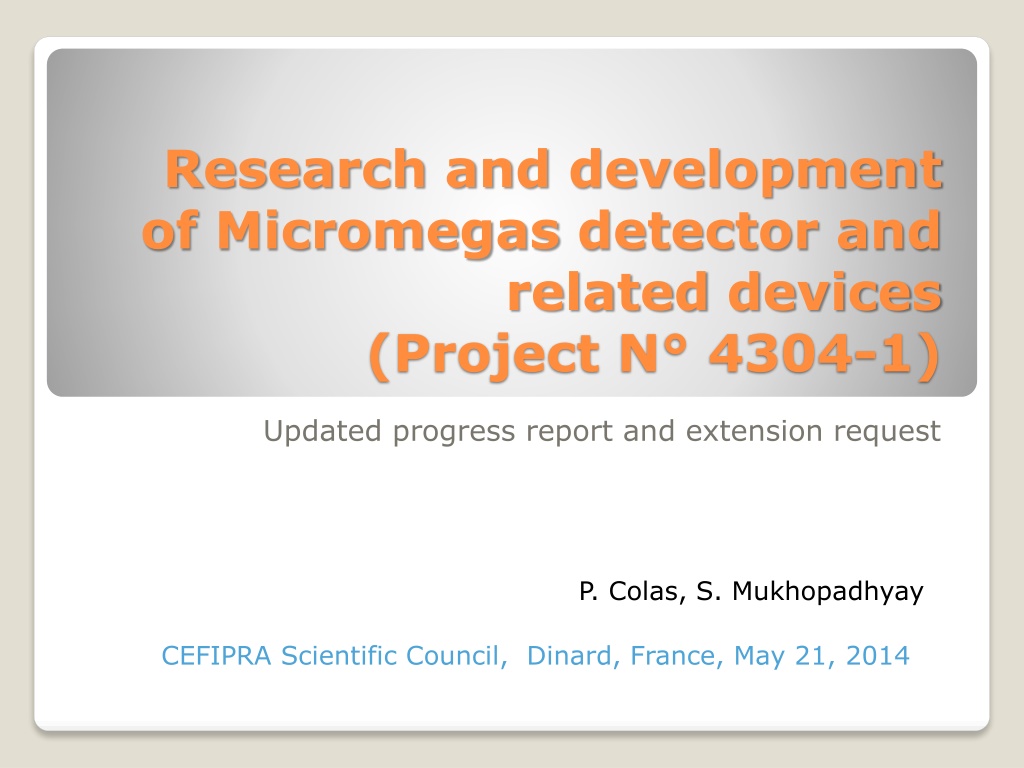Advancements in Micromegas Detector Research Project
Advancements in the research and development of Micromegas detectors and related devices are highlighted in this progress report and extension request. The project, initiated in April 2011, involves studies with small prototypes, software analysis, and significant achievements by the PhD student Deb Sankar Bhattacharya. Collaboration between France and India, along with equipment procurement and publications, have contributed to the project's success. Micromegas Time Projection Chambers, project history, and operational principles are discussed, showcasing the project's evolution and future plans for continued innovation.
Download Presentation

Please find below an Image/Link to download the presentation.
The content on the website is provided AS IS for your information and personal use only. It may not be sold, licensed, or shared on other websites without obtaining consent from the author. Download presentation by click this link. If you encounter any issues during the download, it is possible that the publisher has removed the file from their server.
E N D
Presentation Transcript
Research and development of Micromegas detector and related devices (Project N 4304-1) Updated progress report and extension request P. Colas, S. Mukhopadhyay CEFIPRA Scientific Council, Dinard, France, May 21, 2014
What is a Micromegas Time Projection Chamber? Studies with small prototypes The Large Prototype Software studies, analysis of distortions The PhD student Deb Sankar Bhattacharya Recent achievements Plans Updated report
First meeting in Saclay in December 2008, discussing possible collaborations First travel from France to India in January 2010. Application to CEFIPRA. Started April 1, 2011, due to end on March 31, 2014, extension to January 31, 2016. Documents written : detailed project March 2009, annual report from April 2011 to March 2012, mid-term report presented on Nov. 17, 2012 at the CEFFIPRA S.C. in Aurangabad, the extension proposal in October 2013, this updated progress report and extension request. History of the project 4304-1
Y. Giomataris, Ph. Rebourgeard, JP Robert and G. Charpak, S1 NIM A 376 (1996) 29 Micromesh Gaseous Chamber: a micromesh supported by 50-100 m insulating pillars, and held at Vanode 400 V Multiplication (up to 105 or more) takes place between the anode and the mesh and the charge is collected on the anode (one stage) Funnel field lines: electron transparency very close to 1 for thin meshes S2 S2/S1 = Edrift/Eamplif~ 200/60000= 1/300 Small gap: fast collection of ions Micromegas: How does it work?
t electrons diffuse and Ionizing Particle drift due to the E-field electrons are separated from ions E B A magnetic field reduces electron diffusion y x Micromegas TPC : the amplification is made by a Micromegas Localization in time and x-y 6 TPC: Time Projection Chamber
Full equipment of the SINP lab for small detector studies, and procuration of Micromegas detectors by the Saclay team Study of various gaps and geometry and comparison with simulation 2 publications (NIM and JINST) Work with small prototypes
Ion backflow measurements in Saclay with the Indian team. Work with small prototypes
Joined SINP in January 2013 Registered in PhD at Jadavpur University, with advisors S. Mukhopadhyay, A. Bhattacharya and P. Colas. PhD to be defended in Kolkata, in January 2016. Fully payed on CEFIPRA funds SINP Saclay SINP SINP Saclay 2014 2015 2013 The student Deb Sankar Bhattacharya
Built by LCTPC collaboration Magnet and cooling plant by KEK, Tsukuba Equipped by Saclay with resistive anode Micromegas. Cooling tested in February 2014 at DESY The Large prototype
Software week in Saclay, where we work on the track reconstruction and analysis. Analysis and software
Distortions from the Large Prototype
Inhomogeneity of the Electric field near the edges of the modules induces distortions (even at B=0) Also induces ExB effects Changes in E also changes the drift velocity Add up to mechanical misalignment Detailed module edge layout Distortions from the Large Prototype
Inhomogeneity of the Electric field near the edges of the modules induces distortions (even at B=0) Also induces ExB effects Changes in E also changes the drift velocity Add up to mechanical misalignment Calculations by S. Mukhopadhyay Distortions from the Large Prototype
Lots of achievements after 3 years. French funds not yet spent, but just enough remains to pay salary and expenses of D.S. Bhattacharya through 2015, mainly to study distortions in the Large Prototype TPC 2 weeks in Kolkata for the French team, end of October 2014: MPGD workshop and teaching. Conclusion






















